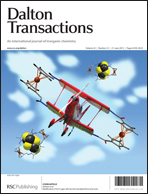A series of multifunctional Cu(II) metal–organic coordination polymers based on three flexible bis-pyridyl-bis-amide ligands and four aromatic dicarboxylates, namely [Cu(3-dpye)(3-NPA)(H2O)]·3H2O (1), [Cu(3-dpye)0.5(5-AIP)(H2O)] (2), [Cu(3-dpye)(1,3-BDC)]·3H2O (3), [Cu3(3-dpye)(1,2-BDC)2(μ2-OH)2] (4), [Cu3(3-dpyb)(1,2-BDC)2(μ2-OH)2] (5), [Cu(3-dpyh)0.5(1,2-BDC)]·H2O (6), [Cu(3-dpyh)0.5(5-AIP)(H2O)] (7) [3-dpye = N,N′-bis(3-pyridinecarboxamide)-1,2-ethane, 3-dpyb = N,N′-bis(3-pyridinecarboxamide)-1,4-butane, 3-dpyh = N,N′-bis(3-pyridinecarboxamide)-1,6-hexane, 3-H2NPA = 3-nitrophthalic acid, 5-H2AIP = 5-aminoisophthalic acid, 1,3-H2BDC = 1,3-benzenedicarboxylic acid, 1,2-H2BDC = 1,2-benzenedicarboxylic acid], have been hydrothermally synthesized and structurally characterized by elemental analyses, IR, PXRD, TG and single crystal X-ray diffraction. X-ray analyses reveal that the seven Cu(II) complexes show three kinds of different 2D layer structures (for complexes 1, 2, 3, 6 and 7) and a 3D coordination framework (for complexes 4 and 5), exhibiting the (44·62) topology for 1, (42·63·8)(42·6) topology for isostructural complexes 2 and 7, (42·67·8)(42·6) topology for complex 3, (3·4·5)2(3·42·5·86)2(32·8·92·10)(42·82·102) topology for isostructural complexes 4 and 5, and the (42·63·8)(42·6) topology for complex 6, respectively. In complexes 1–7, the bis-pyridyl-bis-amide ligands adopt a μ2-bridging mode in 1, 2, 3, 6 and 7 (via ligation of two pyridyl nitrogen atoms) and a μ4-bridging coordination mode in 4 and 5 (via ligation of two pyridyl nitrogen atoms and two carbonyl oxygen atoms), which play an important role in determining the dimensionality of the title complexes. The aromatic dicarboxylates serve as a linker (for 1) and three-connected nodes (for 2–7) to bridge the adjacent Cu(II) ions, respectively, leading to the formation of various topological structures, which indicate both the substitute group and position of carboxyl group of the dicarboxylates play significant roles in the construction of the title complexes. The fluorescent, electrochemical and photocatalytic properties of complexes 1–7 have also been investigated.


 Please wait while we load your content...
Please wait while we load your content...